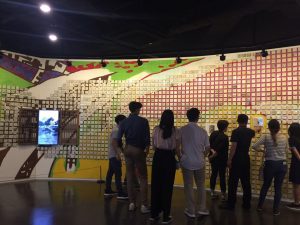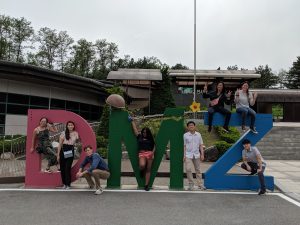Finally, we have finished our first week in Seoul, South Korea.
All of us can agree that the flights to Incheon were SOOOO exhausting. But by the time we arrived to the apartment, the excitement began to build.
On Monday, we got to meet some of the kids at Jiguchon School. It was so reassuring to see that they were as excited to meet us as we were to meet them. We visited the third grade class and they were absolutely delightful. Afterwards, we got to eat lunch with many of the kids and they had so many great questions like “how tall Daniel was” and sweet compliments about how pretty we were. We also got to meet the middle schoolers. Preparing for our lesson plans, all of us couldn’t be more ecstatic to get started teaching. With our expectations set high and with the fantastic guidance of our program director and site coordinator, we are ready to start teaching next week!
The next day we went to the Ministry of Unification Education. There, we spent three days learning about the current North-South Korean relations and the possibilities about reunification. Everyday we participated in lectures and discussions surrounding the current South Korean administration’s position on reunification. They seem to have a very positive outlook on reunification and see it as the inevitable result of the current North-South Korean situation. Most intriguing was the differing positions that different departments of the government seemed to take on reunification. The institute clearly has a more positive, peace-oriented outlook versus the more conservative, strength-oriented position that the military takes. Even more interesting was that even within the ministry positions were slightly different. We got to have a short discussion with the second-in-command in the institute and his position was slightly more optimistic than that of our mentor, Sungwon Lee. In the end, one of my most important takeaways from the experience was that there is not just one solution to the peace relations on the Korea peninsula.
During our three days with the Ministry of Unification Education, we also got to visit various memorials and museums. For me personally, walking through the exhibits at the Odusan Unification Observatory I couldn’t help but feel strangely emotional looking at the history of North and South Korea. I felt especially moved when we went through the exhibit about the many men and women who were in the nineties, sometimes almost a 100, who could not return to their hometowns in North Korea. A group of older men and women walked by while we were looking at the exhibit, exclaiming at the age of the people represented in the exhibit and the content of the memories that the exhibit shared. The legacy of the Korean War still runs deep within the memories of the Korean people.
We also realized throughout the first week that one of the challenges we would face would be to find the balance between “work” and “play.” More simply put, the question is: How do we spend the time that we have in Korea? We hope by asking ourselves this question, we can have a truly effective and rewarding DukeEngage experience.
-Erin
Word vomit:
- It was really interesting to see the different shops that are on the streets near our apartment. Sometimes we saw high-end coffee shops and the right around the corner there was an old more local-looking butcher shop. Times are changing in South Korea.
- There are more foreigners in Seoul than we expected.
- Seoul is definitely a city. You can tell by the smell. (haha)
- Transportation is really good when considering trying to be green. We can really appreciate some mass transport systems!

The DukeEngage team meets the middle schoolers at Jiguchon School.

The DukeEngage Korea team listening to a guide explain one of the exhibits at Odusan

Group photo of the team in front of the bell that both South Koreans and North Koreans ring to bring in the new year.

The DukeEngage team in front of a DMZ sign after going down into the 3rd Infiltration Tunnel.
